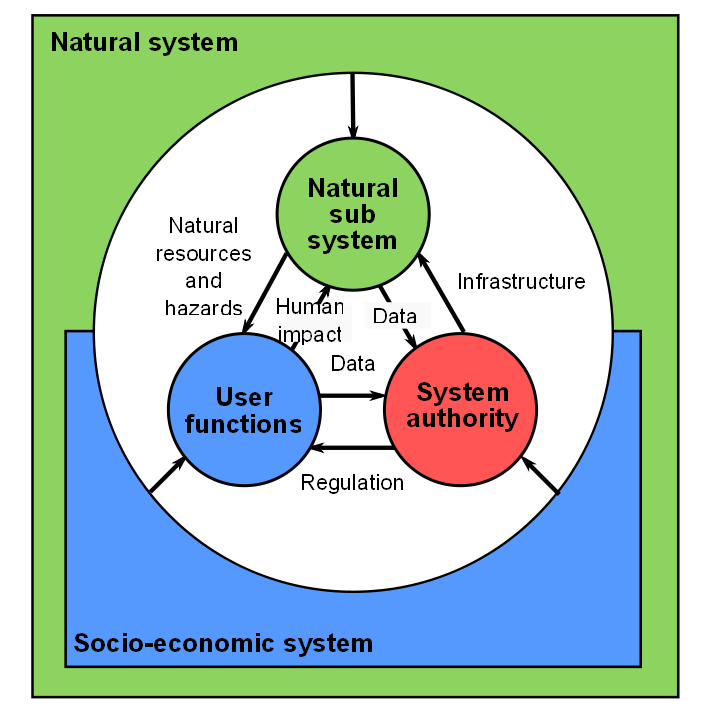About
Subsystems
The figure shows a typical system diagram for projects in a BwN context (Van der Weide, 1993, Van der Weide and Van Koningsveld, 2003). At the highest level of abstraction, the system is controlled by two main elements: the natural system and the socio-economic system. The former includes all components of the abiotic and biotic environment and the latter includes the users, and the required physical and social infrastructure. The natural subsystem is the field of natural sciences whereas social sciences are required to describe the anthropogenic subsystem. The interactions between the two subsystems and their respective structure and internal processes are depicted in the diagram as well.

The interactions between the natural and socio-economic subsystems can be categorised into:
- Environmental services, the positive services provided by the natural system to society. This includes resource use, the use of space and renewable or non-renewable natural resources for social and economic activities
- Natural hazards, the negative impact of nature on the man-made environment
- Positive ecological effects as a result of BwN solutions
- Environmental impacts, the negative impact of social and economic activities on the functions of nature, i.e. the production of renewable resources and the regulation of vital processes
| Natural system ↓ Socio-economic system | Positive: Negative: | 1. Environmental services 2. Natural hazards |
| Socio-economic system ↓ Natural system | Positive: Negative: | 3. BwN solutions 4. Environmental impacts |
The socio-economic subsystem can be divided into a functional (user functions) and regulatory part (system authority). The user functions represent the entire set of human interests in terms of use which is or may be made of the natural resources. The regulatory subsystem contains mechanisms and instruments to control interactions between the natural and socio-economic subsystem. Legislation and institutional arrangements are examples of instruments; the involvement of all stakeholders in the decision making process, as a means to create public support, is an example of a mechanism.
Cross border effects
The systems approach can be applied to different spatial scales. In their books “Limits to Growth” and “Beyond the Limits”, Meadows et al. (1972, 1992) apply a systems approach to the whole world. In practice, however, the system only represents a part of the world. In order to account for the interaction with the environment outside the system, cross border effects have to be included in the system description.
BwN interest
A well-defined system diagram is a useful tool in problem analysis and problem solving. A system analysis for BwN projects should focus on the interaction between various systems. Ecosystem knowledge is especially important for identifying essential supporting services and related natural processes. (e.g. transport, carrying and restoration capacities.) Combining these opportunities that a certain system environment may offer could benefit the project as a whole. Identifying potential win-wins with other projects is another characteristic of a BwN system analysis. Many BwN projects use material that may become available as part of another project. Dredging shipping lanes and harbours generates dredging sludge that may be used for nature restoration purposes or the creation of green defences. Long-term strategies may incorporate a steady stream of dredging sludge, using an incremental development approach. One of the first steps in the EDD-approach is to widen the project scope and make it greener. A proper system analysis in the initiation phase of the project will help to widen the scope. In subsequent project phases the system analysis will still help to identify potential opportunities in combining services and functions.
